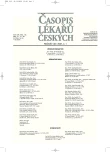The p53 Positivity in Non-tumor Mucosa in Patients with Superficial Urinary Bladder Cancer
Authors:
V. Soukup; M. Babjuk; J. Dušková 1; Martin Pešl; M. Szakácsová; L. Zámečník; J. Dvořáček
Authors‘ workplace:
Urologická klinika 1. LF UK a VFN, Praha
; Patologický ústav 1. LF UK, Praha
1
Published in:
Čas. Lék. čes. 2007; 146: 63-67
Category:
Original Article
Overview
Background.
The aim of the study is to assess the prognostic value of p53 positivity in the non-tumor mucosa of urinary bladder in patients with superficial urinary bladder carcinoma.
Methods and Results.
In 45 patients cold cup non-tumor mucosa samples were taken at the same time with the TUR of superficial urinary bladder carcinoma prospectively. Monoclonal antibody BP53-12-1 was used for the detection of p53 protein. When identifying positive colouring only the nuclear immunoreactivity was being evaluated. 200 nuclei at minimum were examined in several representative fields. The McCarthy method in Bacus modification was used to analyse the findings. It is a semiquantitative method which detects not only the percentage of p53 positive cells but also the intensity of positivity classified into four degrees (0 – negative, 1 – slightly positive, 2 – distinctly positive, 3 – strongly positive). The intensity of p53 positivity was quantified as HSCORE, where HSCORE = ΣPi (i + 1), in which i is one of the four see above degrees and Pi fluctuates from 0 % to 100 %. The result is a numerical figure from 100–400. A negative finding is of HSCORE 100, HSCORE of 400 is the highest possible. The samples were analysed in the analytical system LUCIA. The borderline value was quantified to HSCORE 200. All patients were carefully followed up and treated using usual schemes. The results were evaluated by the use of SAS system (Cary, USA). Thirty patients recurred during the follow-up and 7 of them progressed. The average HSCORE in those who did not recur was 130.2, in patients with the recurrence of tumor it was 162.5 and in patients with progression it was 169.2. We have found a correlation between the HSCORE and the risk of recurrence, which was statistically significant.
Conclusions.
The p53 positivity in non-tumor mucosa of urinary bladder in patients with superficial bladder cancer may bring additional information when predicting the risk of recurrence. More extensive studies need to be carried out.
Key words:
bladder carcinoma, p53 protein, non-tumor mucosa, multifocality.
Labels
Addictology Allergology and clinical immunology Angiology Audiology Clinical biochemistry Dermatology & STDs Paediatric gastroenterology Paediatric surgery Paediatric cardiology Paediatric neurology Paediatric ENT Paediatric psychiatry Paediatric rheumatology Diabetology Pharmacy Vascular surgery Pain management Dental HygienistArticle was published in
Journal of Czech Physicians

Most read in this issue
- Lower Dyspeptic Syndrome Recommended Diagnostic and Therapeutic Practice for General Practitioners 2006
- HIV/AIDS and Pathology in Blood Count
- Incidence of Hiatal Hernias in the Current Endoscopic Praxis
- Postoperative Pulmonary Thromboembolism and Nosocomial Pneumonias: Differential Diagnosis
